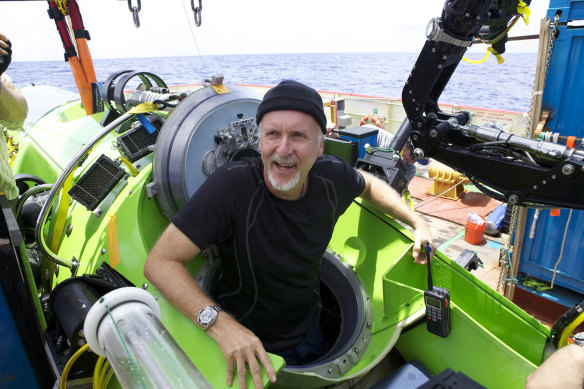Sydney designer of James Cameron’s submersible describes what can go wrong
Save articles for later
Add articles to your saved list and come back to them any time.
Implosions, fishing net entanglements and electrical system faults are some of the many things that can go wrong when sending a submersible to the bottom of the ocean, a Sydney deep-sea explorer says.
Ron Allum, the designer of the vessel that took movie director James Cameron down to the Titanic, says occupants of the missing OceanGate Titan face a desperate outlook.
Ron Allum with parts of his test pressure vessel. He says he checked every part of the submersible James Cameron used to view the Titanic.Credit: Janie Barrett
“As time goes by, it does look quite grim, I would say,” he said.
Allum’s submersible, the Deepsea Challenger, carried Titanic movie director Cameron to the bottom of the trench in 2012.
He said Cameron’s successful voyage led the way for wealthy adventurers to start carrying out their own missions.
“[Cameron] proved that building a submersible was within the realms of a fairly rich, wealthy person and that a number of these people are very passionate about the environment and they like to think of themselves as adventurers,” Allum said.
Cameron himself described how “one line of code” forced him to abort one mission when he could not gauge the depth.
“I had to drop the ballast rates and come back up,” Cameron said.
Allum said difficulties would become more frequent as a growing number of entrepreneurs and scientists created submersibles.
“I think the industry itself has had a fairly good track record and they have even expressed a bit of concern about the OceanGate submersible,” he said.
James Cameron emerging from the Deepsea Challenger in 2012.Credit: AP Photo/National Geographic, Mark Thiessen
“I think very rarely would it be a catastrophic failure. There was a US remotely operated vehicle that suffered a series of implosions when doing a deep dive in the Pacific Ocean.
“The other risk factor would be in the launch recovery – the weather window to dive is so critical for recovery.
“There’s always the occasional entanglement [with fishing nets] … When it comes to manned submersibles, I don’t know of any instances being catastrophic.”
Allum said something significant must have happened for the Titan to have lost communication.
“Submersibles usually carry equipment like sonar, forward-looking sonar or depth sounder-based instruments and these often are outside the pressure hole in their own pressure vessels,” he said.
“If you have one of those [electrical systems] implode, it could take out the communication system. There could have been water get into an electrical system and it has tripped the electrical circuits.”
An electrical fault would explain why the submersible is unable to release weight and has lost communication.
“These bangs that are at regular intervals … that suggests that they’re still alive and they’re still on the ocean floor. Obviously the time’s ticking, they’re going to get very cold, and also the situation you’ve got a limited amount of life support,” Allum said.
“If you turn off your lights at the bottom of the ocean, it is pitch black … you couldn’t even see your hand in front of your face.”
Allum said the best thing the group could be doing is conserving oxygen and resting. Their only hope if they are at the bottom of the ocean would be for a remotely operated vehicle to find them, he said.
“I think that will give them a little bit of hope that they could be on the surface in about 12 hours,” he said.
The Morning Edition newsletter is our guide to the day’s most important and interesting stories, analysis and insights. Sign up here.
Most Viewed in National
From our partners
Source: Read Full Article



